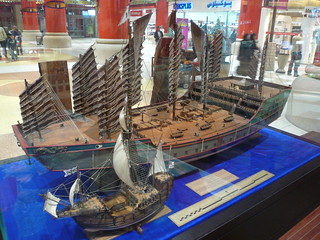
Posted on 07/09/2015 4:50:03 PM PDT by Fractal Trader

That’s ridiculozzzzzzzzzzzzzzzzzzzzz...
Like
Thanks cripplecreek, and I wholeheartedly agree. That's suggested by the pattern of large population increases and sudden civilization and population collapses in PreColumbian Central America.
The problem I have with different takes on the idea that the Great Lakes copper fueled the Mediterranean bronze age (most recently, Gavin Menzies in his book on the Minoans) are the navigational barriers, such as Niagara Falls. Until the construction of the 18th- and 19th-century canals (to some extent), the Soo Locks, and the 20th century St Lawrence seaway, moving literally millions of tons of copper out of Lake Superior and into world trade routes, by water, appears to have been (ahem) impractical.
If it can found that there was an ancient PreColumbian canal system leading from Huron to Ontario for example, I’d probably be all on board, despite the major drop from Superior to Huron.
Another thing I’d regard as hard evidence would be an ancient, Med-style wreck (or ancient American wreck) loaded with copper and just setting where it sank, at the bottom of Lakes Superior, Huron, Erie, or Ontario, or as Menzies would have it, Lake Michigan.
I am of a similar opinion. The 'missing' copper cannot be found in the Americas is a good argument for it being some where else though, lol.
A matching of the isotopes in Med/Michigan copper would convince me.
One of the problems with the “missing” copper arguments is that it isn’t necessarily missing; the copper shows up in sites all over North and Central America. While that shows that it did move long distances, it probably moved overland, or in small quantities via canoe. Another problem is, how much was actually mined? Estimates are fine, but can’t be used very effectively as evidence.
One of the problems on the other side of the question is, where did the copper in the ancient Mediterranean market originate? Cyprus (which apparently got its name from copper itself) was an important source, and the oxhide ingots found on, for example, the Ulu Burun wreck, look like the oxhide ingots portrayed in at least one bit of Egyptian wall art — and the copper is attributed to Keftiu, a transliteration of Caphtor, which was Cyprus (not Crete, as is generally claimed, including in Menzies’ book).
[snip] If Caphtor is not Cyprus, then the Old Testament completely omits reference to this large island close to the Syrian coast. The phonetics of the name also point to Cyprus. Separately I show that Tarshish was the name of Crete. [/snip] http://www.varchive.org/ce/baalbek/caphtor.htm
[snip] The identities of the first two countries mentioned by Esarhaddon are known: Iadanan is Cyprus and Iaman is the Ionian coast of Asia Minor; the location of Tarshishi, however, became the subject of some debate, for this statement by Esarhaddon is the only time the name appears in any Assyrian text. It was noted that “Tarshishi” has the determinative mat for “country” in front of it, as do Idanana, or Cyprus and Iaman, or Ionia. The only clue to its location was its being described as a kingdom “amidst the sea”, apparently somewhat farther removed from Assyria than either Cyprus or Ionia. [/snip] http://www.varchive.org/nldag/tarshish.htm
The mined copper went somewhere as American Indians used very little mainly for ornaments. I don’t think its too much of a stretch to think it moved mainly through the Mississippi river system.
We should be able to agree a lot of copper was mined over perhaps a thousand years in upper Michigan. Where do you suggest the bulk of it went?
Well, that would explain why the Basques and the Blackfeet Indians are the two peoples with highest percentage of Rh negative blood. I could never figure out how the Blackfeet got that blood.
Admiral He divided his fleet of some 800 great shiresps into 5 smaller fleets and sent them in different directions. He was only with one of those 5 fleets so did not travel to the other 4 locations.
So far as Africans settlong Cemtral America, my guess is that some Africans served as mercenaries on some Mediterranian ships (Sea People, Phonecians, Early Greeks). My guess is that ship or ships were wrecked along the Mexican or Central American shores, and then a powerful African ended up controlling the group and then the local population. I believe these giant heads were carved around the same time Egypt was carving giant statues of the late 18th or early 19th dynasties. So an African mercenary could have seen them and wanted to be remembered the same way.
Disclaimer: Opinions posted on Free Republic are those of the individual posters and do not necessarily represent the opinion of Free Republic or its management. All materials posted herein are protected by copyright law and the exemption for fair use of copyrighted works.